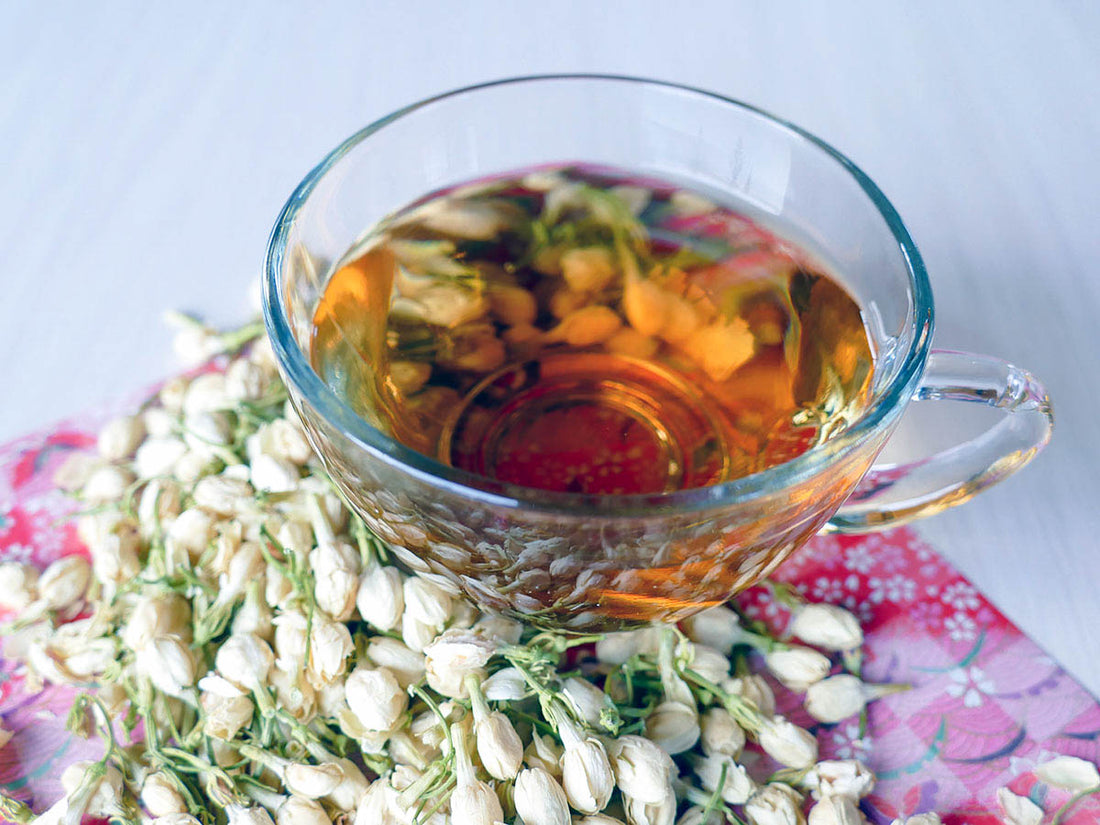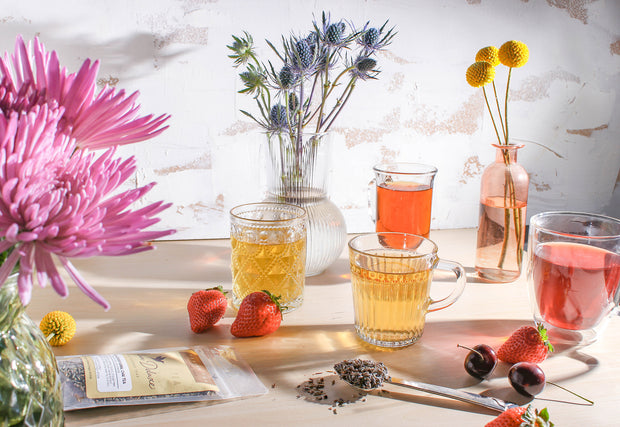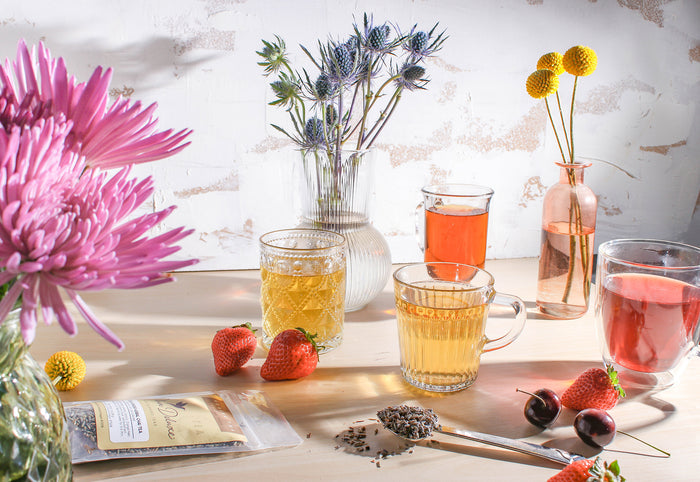Answering the question of whether jasmine tea is a green tea is easy: the answer is sometimes.
See? Wasn’t that easy?
Alas, easy answers aren’t always meaningful answers, so let’s put on the kettle and have another go, eh?
Jasmine tea and green tea are not the same things; however, jasmine tea can be a kind of green tea.
Hmmm. This is harder than I thought. Let’s back up.
Camellia Sinensis, the “True” Tea Plant
The word “tea” is used to describe a range of liquids, plants, scents, and flavors. For instance, compost tea is a favorite bevvy of my garden, and tea tree oil comes from the Australian tea tree, Melaleuca alternifolia. But there is just one evergreen shrub that produces leaves used for the tea we drink: Camellia sinensis.
Green tea is made from the leaves and leaf buds of Camellia sinensis, sometimes called the “true” tea plant. It is a sibling of black, white, yellow, oolong, and puerh teas, all of which come from Camellia sinensis. The siblings are processed differently, yielding different flavors, colors, caffeine levels, and more.
Green tea, like its siblings, is often the base of a tea blend to which other fragrances and flavors are added. Jasmine flowers are one such additive, which is what gives us jasmine tea.
The Jasminum Genus
Jasmine, sometimes spelled “jessamine” and officially called Jasminum, is a genus of shrubs and vines in the olive family.
Olive? Who knew?
The Jasminum genus contains roughly 200 different species, cultivated primarily for the familiar and delicious jasmine scent.
As if 200 different species aren’t enough to muddy tea waters, the name “jasmine” is given to some plants not in the Jasminum genus at all. (Huh. Sound familiar?) Brazilian jasmine, night-blooming and night-flowering jasmines (yes, they are different), star jasmine, and jasmine rice— none of these are in the Jasminum genus, and as far as I know, they’re not used for teas.
Two species commonly used for jasmine tea are Jasminum officinale and Jasminum sambac.

How is Jasmine Tea Made?
You might look at a package of jasmine tea and see nothing but dried green leaves. That’s because the tea is traditionally scented rather than blended.
Tea leaves are harvested in spring, processed into green tea, and stored until fall when jasmine plants bloom. Workers harvest jasmine flowers in the morning when the petals are closed and keep them cool until they open in the evening, releasing their fragrance.
The best traditional jasmine teas (read: most expensive) are made by layering trays of jasmine flowers with trays of dried green tea leaves. When the flowers open, the green tea leaves absorb moisture and fragrance from the flowers, which translates into that enchanting jasmine flavor some of us can’t live without. Top-grade jasmine teas may go through the scenting process half a dozen times for a stronger flavor.
After this process, the wilted jasmine flowers may be added to other tea leaves to produce a cheaper (and still delicious) product. Jasmine tea may be made in other ways, as well, using jasmine essential oil, extract, dried flowers, or some other blend of ingredients and magic.
Jasmine Tea Forms
Jasmine tea comes to us consumers in some unique ways. We may get the familiar loose leaves or tea bags, or we might try hand-rolled jasmine “pearls” or a larger sphere of “blooming jasmine.”
Jasmine pearls are pea-sized balls of rolled leaves or perhaps rolled tea leaves with jasmine flowers. When steeped, pearls unroll and release their flavor.
Blooming jasmine tea (or flowering jasmine tea) is a carefully assembled sphere, the size of a small cotton ball. It is best steeped in a clear glass container, even if it’s just a canning jar, as this is a delicious treat for the eyes as well as the nose and mouth. A blooming jasmine ball opens into a bouquet as it makes a yummy cup of tea.
So much fun! These are great for tea parties.
What Does Jasmine Tea Taste Like?
Straight-up jasmine green tea tastes like jasmine flowers smell, which is to say floral. This floral flavor can be subtle or strong, depending on how the tea was scented, flavored, or blended and what base tea was used. A lightly scented tea will taste more like its base tea than a strongly scented tea.
Although we’re talking about jasmine green tea here, jasmine is also used to scent white, oolong, and black tea bases, and that affects the flavor.
Jasmine tea is considered a good introductory tea because fledgling tea sippers prefer the strong floral flavor to the grassier green tea flavor, but this long-time tea guzzler still gets excited about a good, fragrant jasmine cuppa. It’s why I have a giant bag of dried jasmine flowers that I can add to any cup of tea.

Plum Deluxe Jasmine Teas
At Plum Deluxe, Hope Blend green tea is the jasmine tea staple, made with a delicately scented green tea blended with dried jasmine buds and threads of lovely blue cornflower petals. It’s a soft, sweet, comforting brew. I like it as a gentle wake-up in the morning or a calming midday or afternoon meditation tea.
Jasmine tea gets a fresh makeover in Garden Grove green tea. Here, jasmine and rose floral flavors are brightened with tart cherry and sweet vanilla for a punchy, pick-me-up flavor.
Leave it to Plum Deluxe to recognize and bring out the perky prospects of delicate florals. I’ll be watching to see what new jasmine wonder our tea blenders come up with next!
Both of these jasmine teas take kindly to sweeteners if that’s your thing, but I love them plain.
So, is jasmine tea a green tea? Yeah, sometimes.

![Spring Break Tea Variety Pack [6-Pack Variety of Flavors]](http://www.plumdeluxe.com/cdn/shop/files/spring-break-pack.jpg?v=1740682266&width=165)















